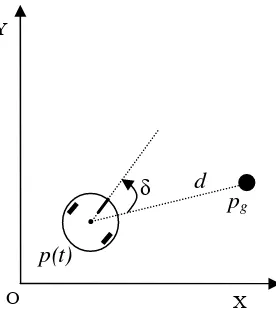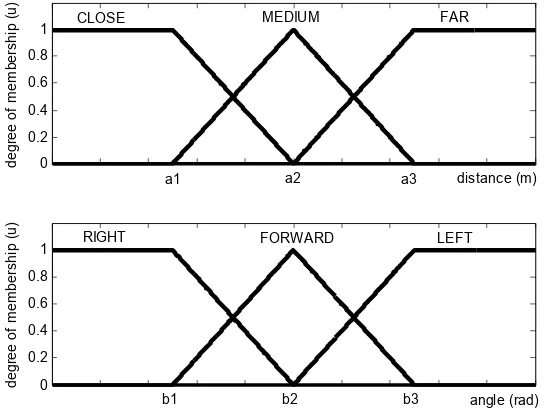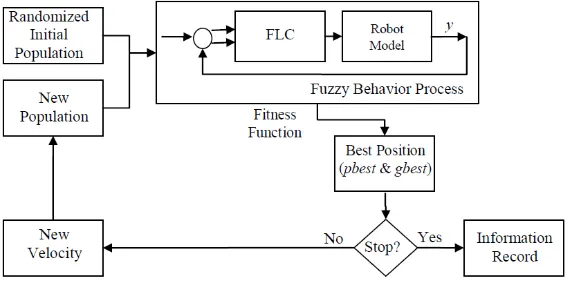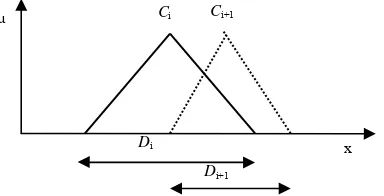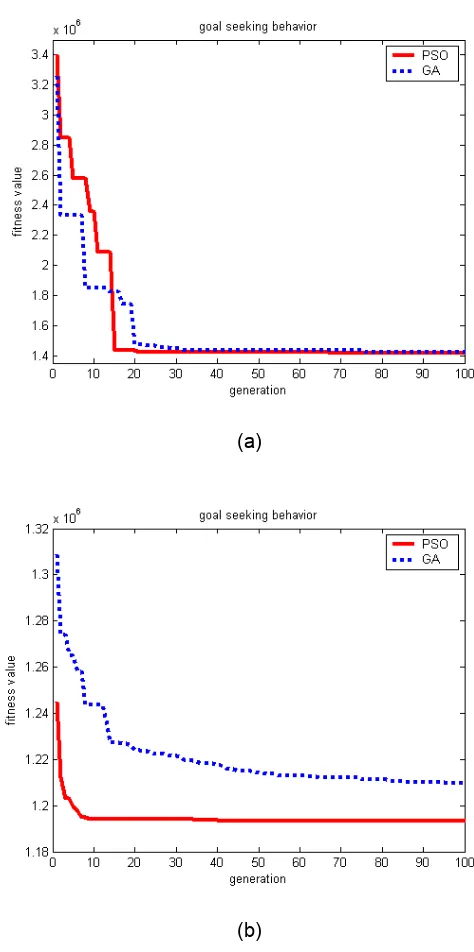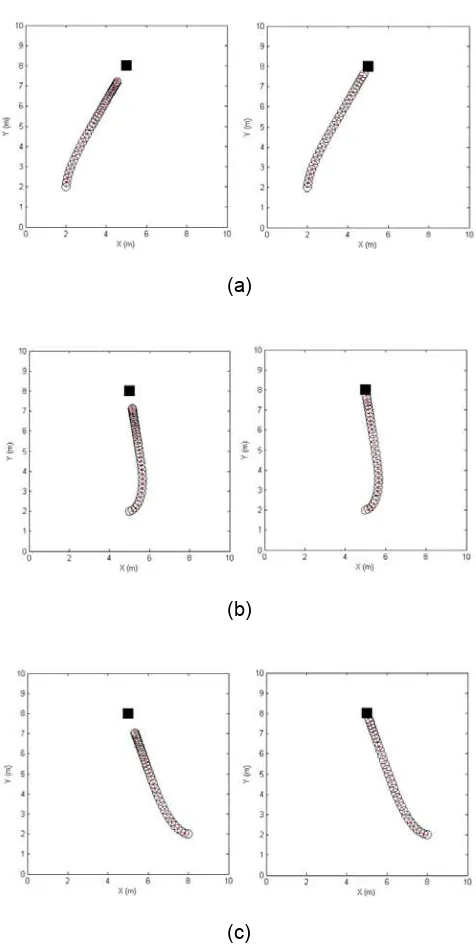DOI: 10.12928/TELKOMNIKA.v13i2.1111 528
Goal-Seeking Behavior-Based Mobile Robot Using
Particle Swarm Fuzzy Controller
Andi Adriansyah*, Yudhi Gunardi, Badaruddin, Eko Ihsanto
Electrical Engineering Departement, Faculty of Engineering, Universitas Mercu Buana Jl. Meruya Selatan, Kembangan, Jakarta Barat, 11650, Indonesia
*Corresponding author, e-mail: [email protected]
Abstract
Behavior-based control architecture has successfully demonstrated their competence in mobile robot development. Fuzzy logic system characteristics are suitable to address the behavior design problems. However, there are difficulties encountered when setting fuzzy parameters manually. Therefore, most of the works in the field generate certain interest for the study of fuzzy systems with added learning capabilities. This paper presents the development of fuzzy behavior-based control architecture using Particle Swarm Optimization (PSO). A goal-seeking behaviors based on Particle Swarm Fuzzy Controller (PSFC) are developed using the modified PSO with two stages of the PSFC process. Several simulations and experiments with MagellanPro mobile robot have been performed to analyze the performance of the algorithm. The promising results have proved that the proposed control architecture for mobile robot has better capability to accomplish useful task in real office-like environment.
Keywords: Behavior-Based Robot, Fuzzy Logic, PSO, PSFC
1. Introduction
Developing a mobile robot is an interesting task. Usually, the mobile robot should face unpredictable environment, perceive inaccurate sensor and act with unsatisfactory actuator in high-speed response [1],[2]. Behavior-based control architecture is an alternative method appropriate to address these problems [3]-[7]. The architecture is able to act with fast real-time response, provides for higher-level deliberation and has demonstrated its reliable performance in standard robotic activities. However, a kind of soft computing is needed to complete two key issues in behavior-based systems, such as generating optimal individual behavior and coordinating multiple behaviors.
Currently, several methods that hybrid fuzzy system with evolutionary algorithms has been proposed in behavior-based mobile robot, such as Genetic Algorithm [8],[9], Genetic Programming [10] to overcome the behavior-based issues. However, the existing evolutionary algorithms used have several drawbacks [11], such as not easy to implement and computationally expensive [12], require much process should be completed and parameters should be adjusted, have slow convergence ability to find near-optimum solution, and dependent heuristically to genetic operators [13].
Fortunately, Kennedy and Eberhart introduced the Particle Swarm Optimization (PSO) in 1995 [14],[15]. PSO is one of evolutionary computation technique to find the optimal solution by simulating such social behavior of groups such as fish schooling or bird flocking. There are several advantages of the PSO as compared to other evolutionary computation methods. The PSO is easy to implement and is computationally inexpensive since its memory and CPU speed requirements are low. Additionally, the PSO requires only a few process should be completed and parameters to be adjusted. In another side, the PSO has quick convergence ability to find optimum or near-optimum solution. Generally, PSO has proved to be an efficient method for numerous general optimization problems, and in some cases it does not suffer from the problems encountered by other evolutionary computation [11]-[13].
membership function and to learn fuzzy rule base for goal-seeking behavior. This fuzzy tuning and learning is performed to accomplish the best behavior-based system.
2. Research Method
2.1. Goal-seeking Behavior Model
Goal seeking behavior steers and moves the robot to the right direction and reach the goal effectively. The mobile robot movement towards the goal is according to the distance and angle between the current position of the mobile robot and the goal position [16],[17]. In this work, MagellanPro mobile robot is used for verification and performance analysis of the proposed algorithm. The MagellanPro is a circular mobile robot from iRobot, Real World Interface (RWI), the acknowledged industry leader in the exciting field of cutting-edge mobile robotic. The dimension of the robot is as follows: D = 40.64 cm, H = 25.4 cm, r = 5.7 cm, W = 36 cm and M = 18.2 kg, where D is diameter, H is height, r is the radius of wheels, W is distance between two wheels, and M is weight, respectively. Figure 1 shows the physical structure of MagellanPro mobile robot.
Figure 1. MagellanPro Mobile Robot
Figure 2 illustrated a model of MagellanPro mobile robot for simulation exercises for the proposed algorithm. The mobile robot is located on a two dimensional Cartesian workspace, in which a global coordinate {X,O,Y} is defined. The robot has three degrees of parameter position that are represented by a posture pc = (xc, yc, θc), where (xc, yc) indicate the spatial position of
the robot guide point in the global coordinate system and θc is the heading angle of the robot
counter-clockwise from the x-axis.
Figure 2. Model of MagellanPro mobile robot X
xc C
D 2r
yc
The mathematical model for the robot movement can be obtained with differentially steered drive system or known as differential drive system [18]. Based on this system, the robot can move to different positions and orientations as a function of time. The derivatives of x, y and θ can be obtained as
robot is such as follows:
t
In maintaining a course to a goal location, or searching, an effective strategy called as aiming navigation [19] is used. The mobile robot aiming at a goal has to orient its body axis such that the goal is in front of it. The goal must be associated with some salient cue. In this work, the goal is prior specified by the human user. Furthermore, by means of odometry strategy, both the direction and the distance to the goal are acquired. Finally, the goal can be approached from various directions, as illustrated in Figure 3. This technique is simple, fast, and has no cumulative error reroute to the goal.
In the direction of moving to a goal point, mobile robots need to know its relative position. By some modification, integrating and applying the initial position of the robot as x(0) = x0, y(0) = y0, and θ(0) = θ0yields:
where vr and vl are the right and the left wheel velocities along the ground, respectively, and the
position of the robot at time t at the coordinate is x(t), y(t), θ(t).
Based on the robot position and heading, the relative position to the goal point is calculated. The relative positions are known as target distance (d) and target angle(δ), where:
2
as the inputs for goal seeking behavior. Fig. 4 illustrates the relative position between the robot and the goal point.
Figure 4. Relative positions between the robot and the goal point
2.2. Fuzzy Goal-seeking Behavior Structure
FLC structure based on Mamdani technique is used in this system. There are two inputs required, named as target distance (d) and target angle (δ). These inputs are obtained by calculation of the relative position between the current position of robot by means of odometer and the goal position, as stated in Equation (13) and Equation (14). Also, there are two output resulted, named as linear velocity, v, and angular velocity, ω.
Trapezoid and triangular shape are used as input membership functions and output membership functions, for fuzzification and defuzzification process, respectively. The relational
function between input and control of a fuzzy behavior are described by means of fuzzy rule base. Each rule is concatenated as:
RBi: if X1 is A1 and X2 is A2 and … Xn is An then Y1 is B1 and Y2 is B2 (15)
Then, the output is obtained by applying the fuzzy rule base inference and the centroid defuzzification scheme, as
where Cox and Dox are the parameters of center and width of output membership functions at
rule i, αi is the product of the degree of membership of each inputs at rule i, and l is the total
number of rules fired. The selected techniques were chosen due to their linearity, computational simplicity, and easy to understand.
Every input of fuzzy has three linguistic terms, which are CLOSE, MEDIUM and FAR for distances and RIGHT, FORWARD and LEFT for angle, as depicted generally in Figure 5 Three linguistic terms is chosen on behalf of the minimal number for fuzzy system. The value of xi and
yi are tuned automatically as described in the next sections.
0
RIGHT FORWARD LEFT
a1 a2 a3
b1 b2 b3
Figure 5. The membership functions of distances and angle
0 0.2 0.4 0.6 0.8 1
v (m/s)
de
gree of
m
e
m
bers
h
ip
(u)
0 0.2 0.4 0.6 0.8 1
w (rad/s)
deg
ree of
m
e
m
bers
h
ip
(u)
LOW MEDIUM HIGH
RIGHT FORWARD LEFT 0.05 0.15 0.25
-pi/4 0 pi/4
Figure 6. The membership function of linear velocity and angular velocity
2.3. PSFC Design
Basically, PSFC is an FLC augmented by a tuning or learning process based on PSO. In PSFC, PSO is applied in order to search for an appropriate Knowledge Base (KB) of a fuzzy system for a particular problem and to ensure those parameter values are optimal with respect to the design criteria. The KB parameters constitute the optimization space, which is then transformed into suitable position on which the search process operates. Figure 7 shows the concept of a PSFC system where PSO design and fuzzy processing are the two fundamental constituents.
Figure 7. The concept of a PSFC
At the beginning of the process, the initial populations comprise a set of particles that are scattered all over the search space. The initial population may be randomly generated or may be partly supplied by the user. However, in this works, the populations are randomized initially.
assignment of the fitness function serves as a guidance to lead the search toward the optimal solution.
Furthermore, for the purposed of tuning fuzzy membership functions the following equations were defined:
Cx = Cx + ki (17)
Dx = Dx + ji (18)
where kiand jiare adjustment coefficients, Cx, and Dx are set of centre and width of each fuzzy
membership function, respectively. The adjustment coefficients take any real positive or negative value. Therefore, ki makes each center of membership function move to the right or
left and the membership functions shrinks or expands through ji, as shown in Fig. 8. The
shifting coding strategy will simplify searching computation, because there is no necessity to sort the value of membership functions in ascending manner.
Figure 8. Principle in tuning of membership function
The PSO process starts with randomly generated initial populations. Then, all populations of particles are evaluated and associated based on fitness function to determine the pbest and gbest. Based on several initial investigations and trials and errors, the fitness functions for goal seeking can be obtained as
where I is the total number of start position, K is the number of step simulation for each start position, eθ is the angle error, ed is the distance error, ω(k), and v(k) are the linear velocity and
angular velocity at k, respectively.
In this work, a Sigmoid Decreasing Inertia Weight (SDIW) is used to provide faster speed of convergence and better accuracy of optimized value [20]. Consequently, PSFC would generate optimal and reliable goal-seeking behavior of the mobile robot.
3. Results and Discussion
Several experiments exercises have been performed. Some steps of experiments have been designed. Firstly, a PSFC optimization processes is conducted to find the optimized value of fuzzy parameters. Then, simulations of the mobile robot based on the PSFC are analyzed to investigate the control behavior of PSFC. Results of fuzzy behavior that are obtained manually, obtained by GA, called as Genetic Fuzzy Controller (GFC) from previous works are used as comparison [21]. Finally, a real robot, MagellanPro, movements are tested to go to some location.
PSO and GA processes for goal-seeking behavior are shown in Figure 9, where, evolutions of the best fitness value against generation are illustrated. At the beginning of the run, the process tended to have more global search ability because of large inertia weight. It was shown that the fitness value over all generations is converging quickly. After that, the process tended to have more local search ability caused by the small value of inertial weight.
Di x
µ Ci Ci+1
(a)
(b)
Figure 9. Comparison of PSO vs. GA process for goal seeking behavior (a) Rule base learning, (b) Membership function tuning
(a)
(b)
(c)
Figure 10. Simulation of mobile robot movements with GA (left) and PSO (right) comparison in differential initial positions
Figure 11. Real robot movement
4. Conclusion
Goal-seeking behavior-based control architecture has successfully demonstrated their competence in mobile robot development. Fuzzy Logic Systems appear to be very useful to develop the high reliable and effective behavior-based system. However, there are difficulties to set membership function and fuzzy rule base in Fuzzy System manually. This paper presents the development of fuzzy goal-seeking behavior-based control architecture using PSO for MagellanPro mobile robot. The work has been done in some tasks: behavioral designing of the mobile robot, designing new fuzzy behavior coordination, and finally, implementing the proposed algorithm in real environment.
Based on the experiment results, the mobile robot is able to deal with goal-seeking behaviors. Generally, it is noted that the proposed control architecture has the good ability to be applied in MagellanPro mobile.
Acknowledgement
The author wishes to express his sincere thanks to the Directorate General of Higher Education, Ministry of Education and Culture which awarded the grant funding for Fundamental Research (Project No. 2013 0263/E5/2014).
References
[1] Widodo NS, Rahman A. Vision Based Self Localization for Humanoid Robot Soccer. TELKOMNIKA Telecommunication Computing Electronics and Control. 2012; 10(4): 637-644.
[2] Wicaksono H, Khoswanto H, Kuswadi S. Teleautonomous Control on Rescue Robot Prototype.
TELKOMNIKA Telecommunication Computing Electronics and Control. 2012; 10(4): 621-628.
[3] Dongshu W, Yusheng Z, Wenjie S. Behavior-Based Hierarchical Fuzzy Control for Mobile Robot Navigation in Dynamic Environment. Chinese Control and Decission Control (CCDC 2011). China. 2011: 2419-2424.
[4] Parasuraman S, Ganapathy V, Shirinzadeh B. Behaviour Based Mobile Robot Navigation Technique AI System: Experimental Investigation on Active Media Pioneer Robot. IIUM Engineering Journal. 2005; 6(2): 13-25.
[5] Bao QY, Li SM, Shang WY, An MJ. A Fuzzy Behavior-based Architecture for Mobile Robot Navigation in Unknown Environments. International Conference on Artificial Intelligence and Computational Intelligence (AICI 2009). Shanghai. 2009: 257-261.
[6] Mo H, Tang Q, Meng L. Behavior-based Fuzzy Control for Mobile Robot Navigation. Mathematical Problems in Engineering. 2013: 1-10.
[7] Khatoon S, Ibraheem. Autonomous Mobiler Robot Navigation by Combining Local and Global Techniques. International Journal of Computer Applications. 2012; 37(3): 1-10.
[8] Sim KB, Byun KS, Lee DW. Design of Fuzzy Controller using Schema Coevolutionary Algorithm.
[9] Merchan-Cruz EA, Moris AS. Fuzzy-GA-based trajectory planner for robot manipulators sharing a common workspace. IEEE Transaction on Robotics. 2006; 22(4): 613-624
[10] Tunstel EW, de Oliveira MAA, Berman S. Fuzzy Behavior Hierarchies for Multi Robot Control.
International Journal of Intelligent Systems. Special Issue: Hierarchical Fuzzy Systems. 2002; 17(5): 449-470.
[11] Saxena A, Saxena A. Review of Soft Computing Techniques used in Robotics Application.
International Journal of Information and Computation Technology. 2013; 3(3): 101-106.
[12] Hassan R, Cohanim B, de Weck O. A Comparison of Particle Swarm Optimization and the Genetic Algorithm. American Institute of Aeronautics and Astronautics. 2004: 1-13.
[13] Jones KO. Comparison of Genetic Algorithm and Particle Swarm Optimization. Proceeding of International Conference on Computer Systems and Technologies. Bulgaria. 2005; IIIA: 1-6.
[14] Eberhart RC, Kennedy J. A new optimizer using particle swarm theory. Proceeding of the Sixth International Symposium on Micro Machine and Human Science. Nagoya. 1995: 39-43.
[15] Kennedy J, Eberhart RC. Particle Swarm Optimization. Proceeding of IEEE International Conference on Neural Networks. IV. Perth. 1995: 1942-1948.
[16] Jisha VR, Ghose D. Goal seeking for robots in unknown environments. International Conf. on Intelligent Robots and Systems (IROS 2010). Taipei. 2010: 4692-4697.
[17] Cherroun L, Boumehraz M. Designing of Goal Seeking and Obstacle Avoidance Behaviors for Mobile Robot using Fuzzy Techniques. Journal Automation and System Engineering. 2012; 6(4): 164-171 [18] Dudek G, Jenkin M. Computational Principles of Mobile Robotics. 1st ed. Cambridge, MA: Cambridge
University Press. 2000.
[19] Franz MO, Mallot HA. Biomimetic robot navigation. Robotics and Autonomous Systems. 2000; 30: 133-153.
[20] Adriansyah A, Amin SHM. Analytical and Empirical Study of Particle Swarm Optimization with a Sigmoid Decreasing Inertia Weight. Regional Postgraduate Conference on Engineering and Science. Johor Bahru. 2006: 247-252.

